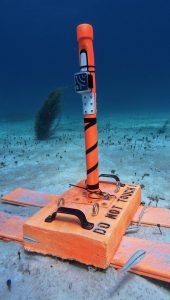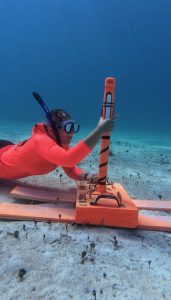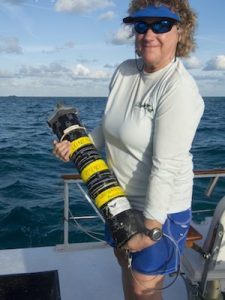Meet the Hydromoth!
We’re excited to introduce our newest research tool—meet the Hydromoth! It’s not just any gadget; this little device is a game-changer for marine mammal research. So, what exactly is a Hydromoth, and why are we so pumped about it?
The Hydromoth is an open-source passive acoustic monitoring (P.A.M.) device that allows us to eavesdrop on the ocean’s happenings without being there ourselves. Being able to listen in on the dolphin’s world, and capture sounds gives us crucial insights into how they communicate, move, and behave. Not only is this technology great at picking up the sounds we can hear it’s sensitive to ultrasonic frequencies too, which opens up a whole new dimension of research. It records high-quality, uncompressed audio, at 384,000 samples per second! This means we can collect detailed data and then sift through it to uncover the dolphin’s acoustic secrets.
 Hydromoth mounted to the base underwater (Photo: Oxana Fedorova)
Hydromoth mounted to the base underwater (Photo: Oxana Fedorova)
Passive Acoustic Monitoring plays a big role in non-invasive research! This allows us to study dolphins without physically being present or accidentally distracting them from their natural behavior. By placing acoustic devices in the water, we can record and monitor dolphin vocalizations, movements, and interactions without disturbing them.
These systems can operate for extended periods, from days to months, continuously or periodically recording sounds. This long term data provides insights into dolphins’ seasonal and daily behaviors that would be difficult to capture through direct
observation alone. The ability to detect and analyze acoustic signals over time helps in understanding dolphins’ communication patterns, movement behaviors, and even social structures. We can study how different environmental factors or human activities affect their acoustic behavior.
 Hayley deploying Hydromoth (Photo: Oxana Fedorova)
Hayley deploying Hydromoth (Photo: Oxana Fedorova)
Our old-school tool for this was the Ecological Acoustic Recorder (E.A.R.), which was an awesome piece of tech that helped us monitor the dolphins. Read about the EAR here: https://www.wilddolphinproject.org/can-hear-now/
 Dr. Herzing holding the EAR
Dr. Herzing holding the EAR
However, like all things in the tech world, evolution happened and the Hydromoth is the next step! Not only does it capture a wider range of frequencies, but it’s also easier to work with and more affordable. This versatility makes it ideal for our research.
But, of course, new tech comes with new challenges. While the Hydromoth is an amazing addition, there’s been some trial and error—testing different base models, figuring out the best way to position the devices on the poles, and seeing how well they capture sound from various distances. Once the units are deployed for a few days, we retrieve them, and that’s when the fun begins. The amount of data these things collect is wild—seriously, it’s like opening a treasure chest of dolphin sounds! But with that comes the challenge of figuring out the best way to process and analyze it all.
Despite the occasional hiccups, we’re super grateful for how much easier the Hydromoth system is to deploy and retrieve compared to the old E.A.R. system. It streamlined the process, made things less physically demanding in the field, and gave us the ability to gather even more data on our dolphin pals. We’re excited to keep refining our methods and can’t wait to see what new insights this device will bring!
As always, stay tuned for more dolphin discoveries!
~ Allison Sanchez
